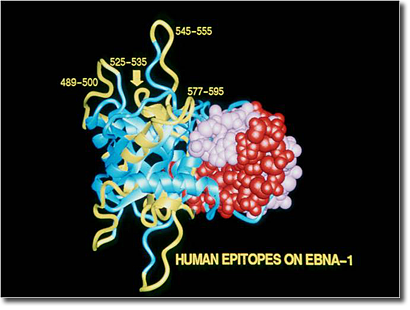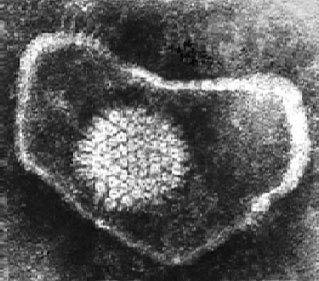Academic Research
Epstein Barr Virus
Clinical Background
Epstein Barr virus (EBV) is the most prevalent member of the human Herpesviruses, infecting more that 90% of the world adult population and has therefore acquired its nickname "EveryBody's Virus".
Recent research in many laboratories throughout the world, aided by new molecular techniques, has revealed that EBV is actively associated with a increasing number of acute, chronic and malignant diseases that have a world-wide occurrance.
 Primary EBV infection usually occurs during childhood, which usually goes unnoticed. However delayed primary infection in adolescents and (young) adults causes Infectious Mononucleosis (IM) or Kissing Disease (also known as Glandular Fever of Pfeiffer's Disease) in 50% of the cases, irrespective of sex or race.
Primary EBV infection usually occurs during childhood, which usually goes unnoticed. However delayed primary infection in adolescents and (young) adults causes Infectious Mononucleosis (IM) or Kissing Disease (also known as Glandular Fever of Pfeiffer's Disease) in 50% of the cases, irrespective of sex or race.
IM is a lymphoproliferative disease causing lymph-node swellings associated with rushes of high fever, severe and prolonged fatigue, liver disfunction (hepatitis) and other debilitating symptoms, which may take a chronic course and last for many months.
The incidence of IM is high (e.g. 1-3% of all first year college students in USA) and still increasing in Europe, USA and Japan, but also increasing in Eastern Europe, South-East Asia and South America due to improving socio-economical conditions.
The IM incidence will increase by delaying natural primary infection early in life as a consequence of improved hygiene and changes in child-feeding habits (i.e. the use of bottled milk and sterilized canned food, in stead of breast milk and pre-chewed local food). Therefore, IM will grow to become a significant problem in young adults all over the world, specially affecting the higher socio-economical classes.
Following primary exposure, a variety of not well defined acute and chronic disease syndromes are described in young children and adults, which may be grouped as chronic severe EBV syndrome (CSEBV) and haemophagocytic syndrome (HPS).
With the increased IM incidence, also the frequency of CSEBV and HPS may increase.
Recently, in 1998, the IARC (International Agency for Research on Cancer) recognized EBV as a group I human carcinogen, confirming its pathogeneic role in a number of different human cancers of both lymphoid (Lymphoma) and epithelial (Carcinoma) origin, that have a world-wide occurrence.
The most prevalent and well known EBV-associated tumors include Burkitt's Lymphoma (most prevalent childhood cancer in Africa), Nasopharyngeal carcinoma (among most prevalent cancers in China and SE-Asia), Hodgkin's Disease (40-90 % world-wide), T/NK-cell Lymphoma, Gastric Cancer (5-15% world-wide) and some other more rare cancers. These tumors arise worldwide in the normal immunocompetent population.
In addition, EBV is the direct cause of most Lymphoproliferative Disease (LPD) episodes and Malignant Lymphoma occurring in patients with immunological defects, such as AIDS-patients and transplant-recipients and in other patients with inherited or acquired (drug-induced) immunodeficiencies .
Finally, EBV is considered to play a (as yet ill defined) role in the pathogenesis of a number of autoimmune diseases, esp. Sjögren's Syndrome and Rheumatoid Arthritis, and may be associated with a considerable number of cases of acute or chronic hepatitis and fever of unknown origin.

